Menus
- Ducati Multistrada 1200 S Touring, Kawasaki Versys 1000, Triumph Tiger 1050 Sport
- Ducati Multistrada 1200 S Touring
- Kawasaki Versys 1000
- Triumph Tiger 1050 Sport
- Technical specifications
- MOTORCYCLE scoring / test result
- Interim balance
- MOTORCYCLE scoring
- MOTORCYCLE test results
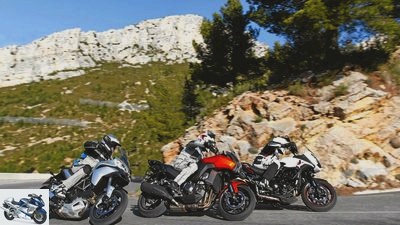
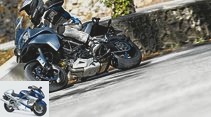
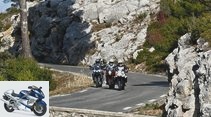
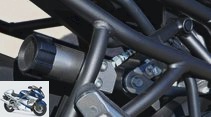
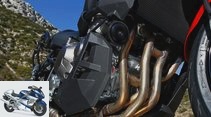
22nd photos
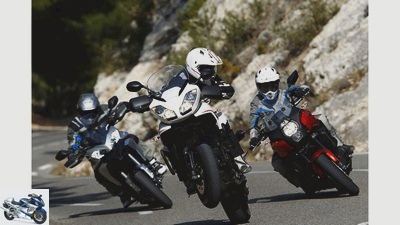
1/22
Ducati Multistrada 1200 S Touring, Kawasaki Versys 1000 and Triumph Tiger 1050 Sport. The funbikes with 17-inch tires in the second part of the big enduro test 2013.
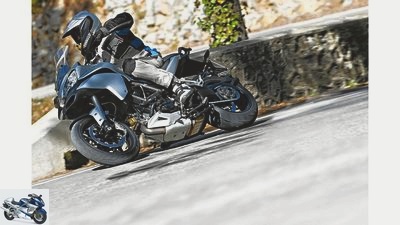
2/22
Ducati Multistrada 1200 S Touring: Fit for spring: At no moment does this competitive athlete allow any doubts about the state of training.
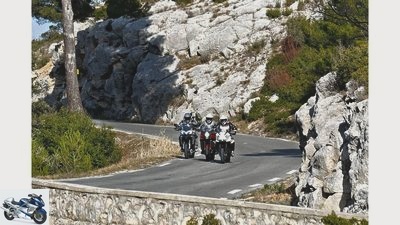
3/22
Ducati Multistrada 1200 S Touring, Kawasaki Versys 1000 and Triumph Tiger 1050 Sport.
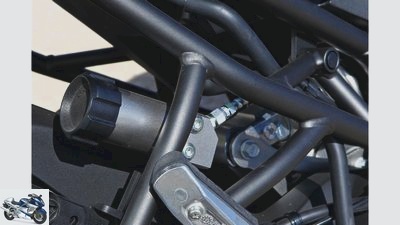
4/22
At the rear, the spring base can be adjusted with a handwheel, the tension damping with a screwdriver.
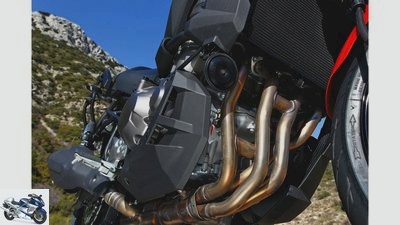
5/22
Exhaust worms and front silencer prevent a main stand.
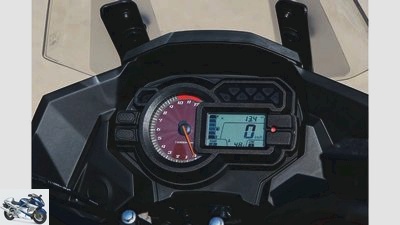
6/22
The Versys offers two engine mappings and a well-functioning traction control, unfortunately, like the Triumph, no gear indicator in the display.
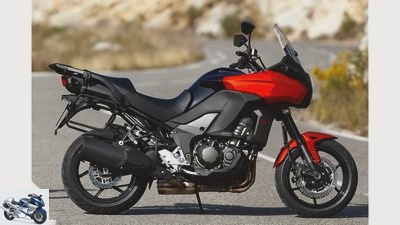
7/22
Kawasaki Versys 1000.
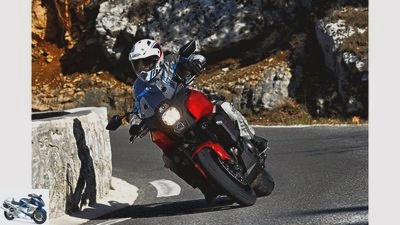
8/22
Kawasaki Versys 1000: The Japan fun bike impresses with the expected gentle four-cylinder character, but surprising agility.
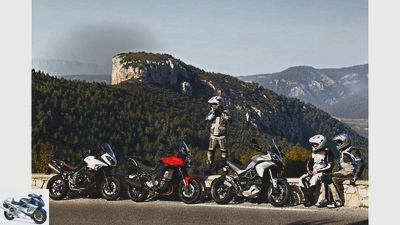
9/22
The best weather, the finest roads, a wonderful landscape and three great fun devices: So just take a break, quickly swap machines – and off you go.
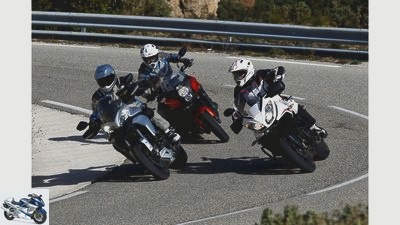
10/22
Ducati Multistrada 1200 S Touring, Kawasaki Versys 1000 and Triumph Tiger 1050 Sport.
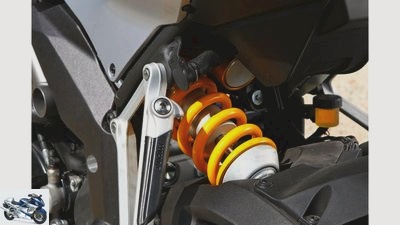
11/22
The suspension looks sporty and firm, but not as hard as a board as on the recently tested machine with pre-series tuning.
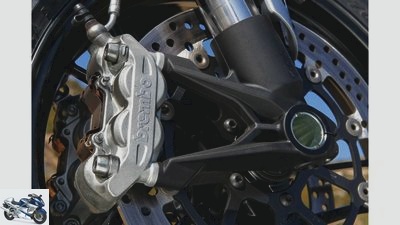
12/22
The brakes with updated ABS control are top notch.

13/22
With so many messages on the display and a complex menu structure, it is easy to lose track of things.
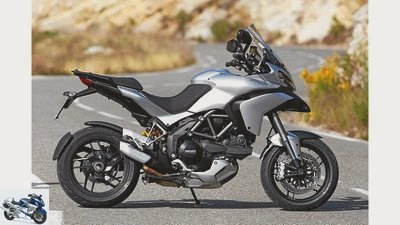
14/22
Ducati Multistrada 1200 S Touring.
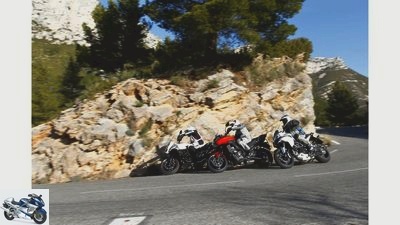
15/22
Triumph Tiger 1050 Sport, Kawasaki Versys 1000 and Ducati Multistrada 1200 S Touring.
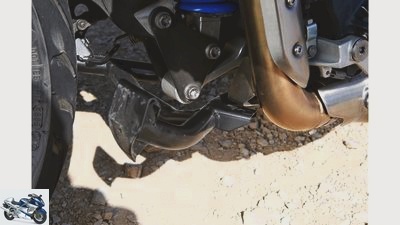
16/22
The optional main stand of the test machine rattled because a rubber stop was apparently missing on the right and the return springs are too slack. The stand folds down to the floor on rough road surfaces.
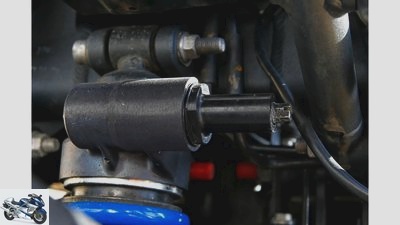
17/22
The spring base adjustable by hexagon.
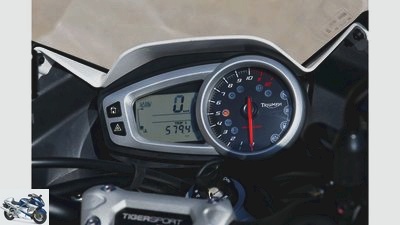
18/22
Spartan cockpit.
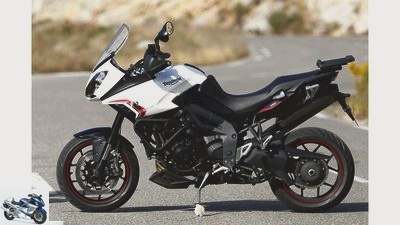
19/22
Triumph Tiger 1050 Sport.
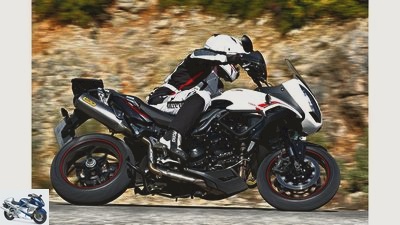
20/22
Triumph Tiger 1050 Sport: The heart, beating strongly in the typical steady three-cylinder rhythm, is the strength of the renovated Sport Tiger.
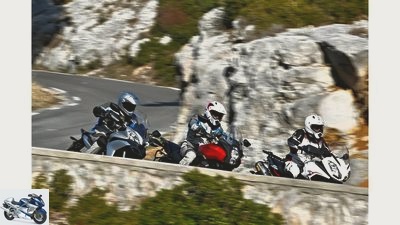
21/22
Ducati Multistrada 1200 S Touring, Kawasaki Versys 1000 and Triumph Tiger 1050 Sport.
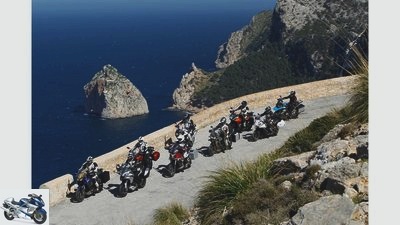
22/22
Interim balance from parts 1 and 2: 19 or 17 inches – so the machines are not that different.
Comparison test of travel enduro bikes, part 2 – Sporty 17-inch fun bikes
Ducati Multistrada 1200 S Touring, Kawasaki Versys 1000, Triumph Tiger 1050 Sport
These three love crisp sprints, but they also have the staying power for marathon distances. And they like to flex their muscles in a competition. Sporty fun bikes with 17-inch tires but different characters that emphasize strength and endurance in an individual way.
E.s tweaks here and there. And the back doesn’t really want anymore either. You’re just not the youngest anymore. When this knowledge matures in the course of a motorcyclist’s life, when the body increasingly crooked the hunchback on the super sports car, then that is by no means a reason for panic reactions. Gently, gently, don’t throw the gun in the grain and rashly swap the spartan sports seat for a comfortable cruiser armchair. There are alternatives. For example, a category that meets the highest demands in terms of driving pleasure and dynamism, but at the same time stows the on-board personnel comfortably and age-appropriately. Incidentally, a young crew is also welcome.
Buy complete article
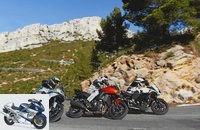
Comparison test of travel enduro bikes, part 2 – Sporty 17-inch fun bikes
Ducati Multistrada 1200 S Touring, Kawasaki Versys 1000, Triumph Tiger 1050 Sport
The Kawasaki Versys 1000 is always well dressed with a row quad purring smoothly through the entire speed range.
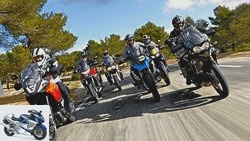
Enduro
Travel enduros in comparison test part 1
Travel enduros with 19-inch front wheels tested
read more
Ducati Multistrada 1200 S Touring
Ducati Multistrada 1200 S Touring: Fit for spring: At no moment does this competitive athlete allow any doubts about the state of training.
The Italians gave this category a huge boost in 2010 with the aggressively styled black-mouth multitool. This had never existed before, this tingling combination of a fast sports engine and a versatile enduro chassis. In addition to the well-known electronic aids, the exclusive S model now also has a sophisticated semi-active “sky-hook” suspension, which permanently adjusts the damping – controlled by four acceleration sensors distributed on the chassis and suspension elements – while driving in fractions of a second. The driver does not notice anything, he selects the desired driving program via the somewhat complicated nested on-board menu – i.e. Sport, Touring, Urban or Enduro, the computer controls the engine mapping, chassis, ABS and traction control accordingly. A smart idea.
In a direct comparison of new versus old, MOTORRAD recently criticized the tough basic set-up of the test machine, which hopped roughly across the asphalt even in the actually soft touring mode.
After the MOTORRAD criticism, the test machine was dismantled in the main factory in Bologna, parts were found in the damper elements that did not belong there, namely from the pre-series tuning. The current test machine comes straight from series production – and works noticeably better.
On the tight side, the suspension is still working, except on extremely bumpy terrain, a sporty pilot can now live with it quite well. Nevertheless: A fundamental superiority of the complex “Skyhook” technology has not yet been revealed to the testers.
Anyway, the Duc works splendidly as long as the driver spurs it on. If you let the reins loose, the Multistrada always prances like a nervous racehorse in front of the start gate. With the current revision of the engine, Ducati had tried to smooth out rough irregularities in the gear pattern – among other things by using the new double ignition.
With limited success, the Multi still reacts rough and aggressively in the partial load range compared to the other two test machines, the two smooth multi-cylinders in the test and also the other twins can do that much better, especially in the lower speed range below 3000 tours. A Ducati-V2 that pounds off as hard as a rock still works best when the throttle valves are turned on. Then the Multistrada snaps out of the curve so that no eye stays dry.
The uncompromising character has remained, after all, the current Multistrada has made a measurable step in terms of gasoline consumption. Thanks to the new mappings, it consumed about half a liter less per 100 kilometers in the test, which increases the range to around 380 kilometers. So long stages are definitely possible. And that without unduly straining the crew’s ability to suffer. So the driver is placed a bit hard on the first impression, but surprisingly in the long run the seat turns out to be not even that uncomfortable, which also applies to the pillion seat. Both passengers enjoy moderate knee angles and a slim, waisted machine.
A brilliant idea is the lightning-fast adjustment of the windshield: up on the expressway with a flick of the wrist and just as easily down again when turning onto the pass route – perfect. Especially since the higher position in terms of wind protection really brings something.
The Multistrada is not only an outstanding razor machine with endless power, it can also convince as a travel machine with smart details and extensive equipment.
Kawasaki Versys 1000
Kawasaki Versys 1000: The Japan fun bike impresses with the expected gentle four-cylinder character, but surprising agility.
When it comes to the visual impression, the expectations of the athletic qualities of the large Versys are not too high. The logic of their concept, namely to implant a straight four-cylinder, of all things, in such a long-legged enduro concept, is not apparent at first glance.
But the Versys surprises skeptics. First of all on the scales: At 241 kilograms, the four-cylinder Trumm is only slightly higher than the compact Ducati, making the Versys one of the lightest machines of its kind.
Anyone who mistrusts numbers will feel it pretty quickly anyway: the 1000 is surprisingly light-footed in the first corners. The handling is astounding, initially nobody believes this agility. Without a lot of physical effort, the Versys scuttles through the trickiest curve formations as a matter of course, handles demanding driving maneuvers with unexpected esprit. Which is not only due to excellent handling and a good balance, but also has to do with the neutral rolling Pirellis. The Scorpion Trail deliver excellent steering precision, clear feedback and good grip on dry roads.
So, in exuberance of emotions, the Kawa driver lets himself into a duel with the Multistrada on the penultimate groove. Brave, brave. If the pace is committed, the Versys will eventually run out of breath. The laxly tuned suspension, which otherwise impresses with a lot of comfort and good responsiveness, seems overwhelmed and tramples over the bumpy ground. So turn right and turn the rebound damping on the shock absorber to the stop. But what has only had a limited effect is that the basic set-up is simply too soft.
In addition, the braking system also has to recognize its limits on such parforce rides. Anyway, the front stoppers seem a little diffuse, after a few hot kilometers downhill the pressure point of the hand lever moves towards the rubber grip. The pegs also create grooves in the asphalt much earlier than on the Multistrada. So it’s better to slow down a bit and let the Duc go, then this special driving pleasure will set in again immediately.
The four-cylinder from the Z 1000 can in principle keep up with any speed; it is a good example of successful throttling. Sure, it doesn’t shoot like a twin, but it pushes the 241 kilogram machine forward emphatically even from low speeds. He then pulls evenly through the belt, in the meantime there is no period of weakness and puts in a few more briquettes at the top to flatten out at 8000 revolutions to not gorgeous, but sufficient 120 hp. Overall, a very cultivated, smooth drive with a wide speed range, which can at best be criticized for fine vibrations in the middle range, especially since the clutch and transmission work perfectly and no multi-cylinder surcharge is due for consumption.
The driving performance documents the very successful engine set-up, in the lower and middle speed range the Versys does not allow itself to be so far dependent on the violently tearing Ducati and always maintains contact with the subjectively much more brawny Triumph.
The four-cylinder has excellent prerequisites for the tourist type of locomotion. There are also other qualities that make the Versys the most comfortable endurance athlete in this comparison. Both passengers are happy about the dresser seating, the handlebars lie casually in the hand. However, the adjustable windshield should like to offer even more wind protection on fast stages. On a big tour you can pack a lot on with just under 220 kilograms and you don’t have to take every gas station with you with a range of 400 kilometers. It’s just a shame that no main stand is available – and the instrumentation is not exactly the latest information technology, not even a gear indicator is offered.
Triumph Tiger 1050 Sport
Triumph Tiger 1050 Sport: The heart, beating strongly in the typical steady three-cylinder rhythm, is the strength of the renovated Sport Tiger.
So up until now we had a hot two-cylinder athlete and a smooth four-cylinder with good all-round qualities. Is the three-cylinder perhaps the ideal compromise? Triumph itself indicates the direction and has given the Tiger 1050 the addition Sport in the current revision. In any case, the pimped up design appears sporty, and in addition to the single-sided swing arm, the technicians donated a performance boost of at least 10 hp. On the MOTORCYCLE test bench it was even a bit more, the Tiger, equipped with an optional Arrow retrofit exhaust, put a whopping 129 hp on the roller just before the rev limiter. The strengthened triple was able to gain just as strongly in the lower range and now forms a nice torque hump between 3500 and 5500 revolutions, which the other two test machines cannot match on paper.
The fact that the Triumph can hardly capitalize on it on the road is also due to the higher weight of 256 kilograms. The current update didn’t make the Sport Tiger any easier. After all, thanks to full torque and a shorter gear ratio, it is just ahead of the Ducati, which has always been geared for a long time. As a precaution, Triumph turns the juice off at 220 km / h, while the other two test machines are allowed to let off steam uncastrated.
As far as the measurements are concerned, the three-cylinder can hardly set itself apart. Nevertheless, it convincingly combines the advantages of two and four-cylinder engines through its wide usable speed range, low vibrations and the predictable, gentle character that is affected here and there by less elegant load changes. You can let the triple roll with relish, challenge it, squeeze it: it always has a suitable answer ready. And with its beefy TDI character it can be moved quite lazily.
Switching is a thing of the past for other reasons. Gear changes are rather bony, especially when zapping through the gearshift box, and the foot often has to push in the next gear with a lot of force, accompanied by unsightly noises. And the clutch also requires a firm hand.
The Triumph should also behave a little more cooperatively in changing curves. It always looks a bit stiff, as if a lot of weight was concentrated around the steering axis. The Pirelli Angel ST tires are certainly not to blame. Because once in an inclined position, the Tiger Sport steers itself neutrally, but always needs a strong hand that emphatically sets the course.
Perhaps a forward-looking sitting posture would help. The endeavor to reduce the seat height and step length leads to a deep seated position in the machine. The knees are spread wide, the notches are quite high due to the wide frame at the bottom, which seems inactive and also very uncomfortable in the long run, especially for tall drivers, especially since the seat falls slightly forward. The bottom line is that Tiger Sport cannot close the gap to Versys in the overall ranking despite the progress made as a result of the revision. Above all, compared to the modern representatives of this category, there is a lack of equipment, up-to-date electronics and setting options.
Two, three or four cylinders – what is the best concept for this category? All three athletes are definitely fit for fun, and the engines in particular inspire in their own unique way. When it comes to top athletic performance, the Ducati is clearly ahead of the curve. The Versys convinces with endurance qualities as a recreational athlete. The strength of triumph is their heart beating in a unique rhythm.
Technical specifications
Ducati Multistrada 1200 S Touring, Kawasaki Versys 1000 and Triumph Tiger 1050 Sport.
| Ducati | Kawasaki | triumph | engine |
| design type | Two-cylinder four-stroke- 90 degree V engine |
Four-cylinder four-stroke- In-line engine |
Three-cylinder four-stroke- In-line engine |
injection | Ø 64 mm | Ø 38 mm | Ø 46 mm |
| coupling | Multi-disc oil bath clutch (Anti-hopping) |
Multi-panes- Oil bath clutch |
Multi-panes- Oil bath clutch |
Bore x stroke | 106.0 x 67.9 mm | 77.0 x 56.0 mm | 79.0 x 71.4 mm |
| Displacement | 1198 cm3 | 1043 cm3 | 1050 cm3 | compression | 11.5: 1 | 10.3: 1 | 12:01 pm |
| power | 108.8 kW (148 hp) at 9250 rpm |
86.8 kW (118 hp) at 9000 rpm |
92.0 kW (125 PS) at 9400 rpm |
Torque | 125 Nm at 7500 rpm | 102 Nm at 7700 rpm | 104 Nm at 6250 rpm |
| landing gear | frame | Tubular space frame from steel |
Tubular frame made of aluminium |
Bridge frame made of aluminium |
| fork | Upside-down fork, Ø 48 mm |
Upside-down fork, Ø 43 mm |
Upside-down fork, Ø 43 mm |
Brakes front / rear | Ø 320/245 mm | Ø 300/250 mm | Ø 320/255 mm |
| Assistance systems | ABS, traction control | ABS, traction control | SECTION | bikes | 3.50 x 17; 6.00 x 17 | 3.50 x 17; 5.50 x 17 | 3.50 x 17; 5.50 x 17 |
| tires | 120/70 ZR 17; 190/55 ZR 17 |
120/70 ZR 17; 180/55 ZR 17 |
120/70 ZR 17; 180/55 ZR 17 |
Tires | Pirelli Scorpion Trail | Pirelli Scorpion Trail, back “K” | Pirelli Angel ST |
| Dimensions + weights | wheelbase | 1530 mm | 1520 mm | 1540 mm |
| Steering head angle | 65.0 degrees | 63.0 degrees | 66.8 degrees | trailing | 110 mm | 107 mm | 90 mm |
| Front / rear suspension travel | 170/170 mm | 150/150 mm | 140/150 mm | Seat height ** | 840 mm | 830 mm | 840 mm |
| Weight with full tank ** | 237 (with suitcases 245) kg | 241 kg | 256 kg | Payload ** | 185 kg | 218 kg | 201 kg |
| Tank capacity | 20 liters | 21 liters | 20 liters | Service intervals | 12,000 km | 6000 km | 10000 km |
| price | 18,790 euros | 11,995 euros | 12 190 euros | Price test motorcycle | 18,790 euros | 11,995 euros | 14 505 euros *** |
| Additional costs | 345 euros | 180 euros | 395 euros | MOTORCYCLE readings |
| Top speed * | 245 km / h | 226 km / h | 220 km / h | acceleration |
| 0-100 km / h | 3.3 sec | 3.5 sec | 3.4 sec | 0-140 km / h | 5.2 sec | 5.5 sec | 5.5 sec |
| 0-200 km / h | 10.1 sec | 12.4 sec | 11.9 sec | Draft |
| 60-100 km / h | 4.1 sec | 3.7 sec | 3.5 sec | 100-140 km / h | 4.3 sec | 4.0 sec | 3.9 sec |
| 140-180 km / h | 4.9 sec | 5.6 sec | 5.6 sec | Consumption highway | 5.3 liters | 5.2 liters | 5.2 liters |
| Reach country road | 377 km | 404 km | 385 km | * Manufacturer information; ** MOTORCYCLE measurements; *** including arrows silencer (820 euros), high windshield (219 euros), engine protection bar (215 euros), hand protection (99 euros), luggage rack (205 euros), heated grips (205 euros), CNC aluminum lever (189 euros) , Main stand (225 euros), CNC brake fluid reservoir (2 x 69 euros) |
MOTORCYCLE scoring / test result
The best weather, the finest roads, a wonderful landscape and three great fun devices: So just take a break, quickly swap machines – and off you go.
engine
Power at a high level: Despite their different characters, all three engines impress with a lot of power across the entire speed range. When it comes to performance, the pounding Ducati V2 is clearly ahead. The Triumph-Triple convinces with great characteristics and smooth running, while the Kawasaki four-cylinder acts rather inconspicuously and doesn’t make any slip.
Winner engine: Ducati
landing gear
The Versys drives surprisingly light-footed and combines good handiness with precise steering behavior. The tightly designed Ducati offers the greatest reserves for a sporty driving style, as well as a variety of setting options thanks to its electronic chassis. Comfort and responsiveness of the suspension are rather mediocre. The Tiger looks massive and more stubborn in curves.
Chassis winner: Ducati
everyday life
Thanks to the extensive full equipment of the Touring model, the Ducati also wins this chapter. This includes the complex on-board electronics and standard cases. The Triumph dispenses with features such as traction control or gear indicators, the Kawasaki at least offers two different engine mappings and a traction control.
Everyday winners: Ducati
security
Here too, the Ducati, which has the most effective braking system, prevails. However, the ABS regulates hard and allows stoppies, while the Versys ABS is foolproof. With the Triumph, rough control processes lead to deductions.
Safety winner: Ducati
costs
And another stage win for Ducati thanks to long inspection intervals of 12,000 km compared to 6000 km for Kawasaki.
Winner cost: Ducati
Winner price-performance
Decent score, lowest price, that results in the best mark by far.
Price-performance winner: Kawasaki
Test result
1. Ducati Multistrada 1200 S Touring
Sports fans are usually right with Ducati, and this also applies to this hammering multitool, which impresses with top equipment and high-tech features. The Ducatisti will get over compromises in comfort.
2. Kawasaki Versys 1000
The ease with which this four-cylinder chunk can be moved is surprising. A comfortable all-rounder with potential for fun, but whose soft suspension setup stands in the way of sporty feats.
3. Triumph Tiger 1050 Sport
The bearish, at the same time cultivated appearing three-cylinder of the massive sports tiger is in top shape. The seating position takes a bit of getting used to, the sparse equipment needs improvement.
Interim balance
Interim balance from parts 1 and 2: 19 or 17 inches – so the machines are not that different.
19 or 17 inches – the machines are not that different. Here is an overview of the 1000-point ratings from parts 1 and 2, which form the basis for the third part of the big travel enduro comparison.
MOTORCYCLE scoring
| Max. score | BMW GS | Ducati Multistrada | Honda Crosstourer | Kawasaki Versys | KTM Adventure | Moto Guzzi Stelvio | Triumph Tiger 1050 Sport | Triumph Tiger Explorer | Yamaha XT1200Z | Overall rating | 1000 | 735 | 695 | 676 | 664 | 714 | 674 | 651 | 691 | 689 | placement | 1. | 3. | 6th. | 9. | 2. | 7th. | 8th. | 4th. | 5. | Price-performance note | 1.0 | 2.0 | 3.3 | 2.4 | 1.9 | 2.0 | 2.4 | 2.5 | 2.4 | 2.5 |
MOTORCYCLE test results
The BMW R 1200 GS is still in first place.
1st BMW R 1200 GS
She came, saw and won. In the sum of its properties, the new GS is the most versatile. It is amazing how much more light-footed and better it drives than the previous 1200.
2. KTM 1190 Adventure
A highly intelligent networked Hammer V2 in a well thought-out, well-equipped environment. Fiery!
3. Ducati Multistrada 1200 S Touring
The fast sports twin made it to the podium with a wide range and modern equipment.
4. Triumph Tiger Explorer XC
It shines with a velvety, elastic motor and complete equipment. Your fork should be better.
5. Yamaha XT 1200 Z Tenere toilet
Easy to swallow, stable chassis with top seating comfort and top-notch brakes. The engine has little punch.
6. Honda Crosstourer
The V4 engine is a technical gem. Sitting position and range should be even better.
7. Moto Guzzi Stelvio 8V
The V2 engine has a strong sound and character. The giant tanker is very precise and balanced.
8. Kawasaki Versys 1000
Only penultimate, but the sleek four-in-line impresses with handling and comfort.
9. Triumph Tiger 1050 Sport
It is certainly not because of the extremely powerful engine that the Sport Tiger brings up the rear.
Related articles
-
Ducati Multistrada 1200, Kawasaki Versys 1000 and Triumph Tiger 1050 in the test
Gargolov Funbikes in comparison test Ducati Multistrada 1200, Kawasaki Versys 1000 and Triumph Tiger 1050 With bags and bags on a big tour or just an…
-
Kawasaki Versys 1000, Triumph Tiger 1050 Sport, Honda Crossrunner in comparison test
28 photos 1/28 After the romping comes the touring: gasoline talks at the former coal port in Karlsruhe….
-
Triumph Tiger 1050 Sport against Kawasaki Z 1000 SX in comparison test
17th photos 1/17 Comparison test between Kawasaki Z 1000 SX and Triumph Tiger 1050 Sport. 2/17 Faster wheel…
-
factstudio.de 29 photos fact 1/29 One against all. Ducati SuperSport S in comparison test with Suzuki GSX-S 1000 F, Kawasaki Z 1000 SX, Honda VFR 800 F…
-
Top test: Ducati Multistrada 1200 S Touring
28 photos 1/28 In a total of four speed levels – Sport, Touring, Urban and Enduro – bits and bytes vary the chassis and engine…
-
Kawasaki Versys 1000 already driven
Wrigth Premiere Kawasaki Versys 1000 Versys with a snappy inline four-cylinder Content of A snappy inline four-cylinder in a touring chassis. With the…
-
Kawasaki Versys 1000 – The four-cylinder tourer
Gargolov Test: Kawasaki Versys 1000 The four-cylinder tourer from Kawasaki Cover long distances in a relaxed manner with a pillion passenger and a lot of…
-
Triumph Tiger 1050 Sport in the driving report
Manufacturer 25th photos triumph 1/25 Triumph Tiger Sport. triumph 2/25 Triumph Tiger Sport. triumph 3/25 Triumph Tiger Sport. triumph 4/25 Triumph Tiger…
-
Jahn comparison test of supersports: Ducati 998, Honda Fireblade, Kawasaki ZX-9R, Suzuki GSX-R 1000, Triumph Daytona 955i Centennial The K-Question Five …
-
Comparison test Kawasaki GTR 1000, Triumph Trophy 1200, Yamaha FJR 1300
fact comparison test Kawasaki GTR 1000, Triumph Trophy 1200, Yamaha FJR 1300 As time goes by In honor grayed out ?? and still to have: two veteran …